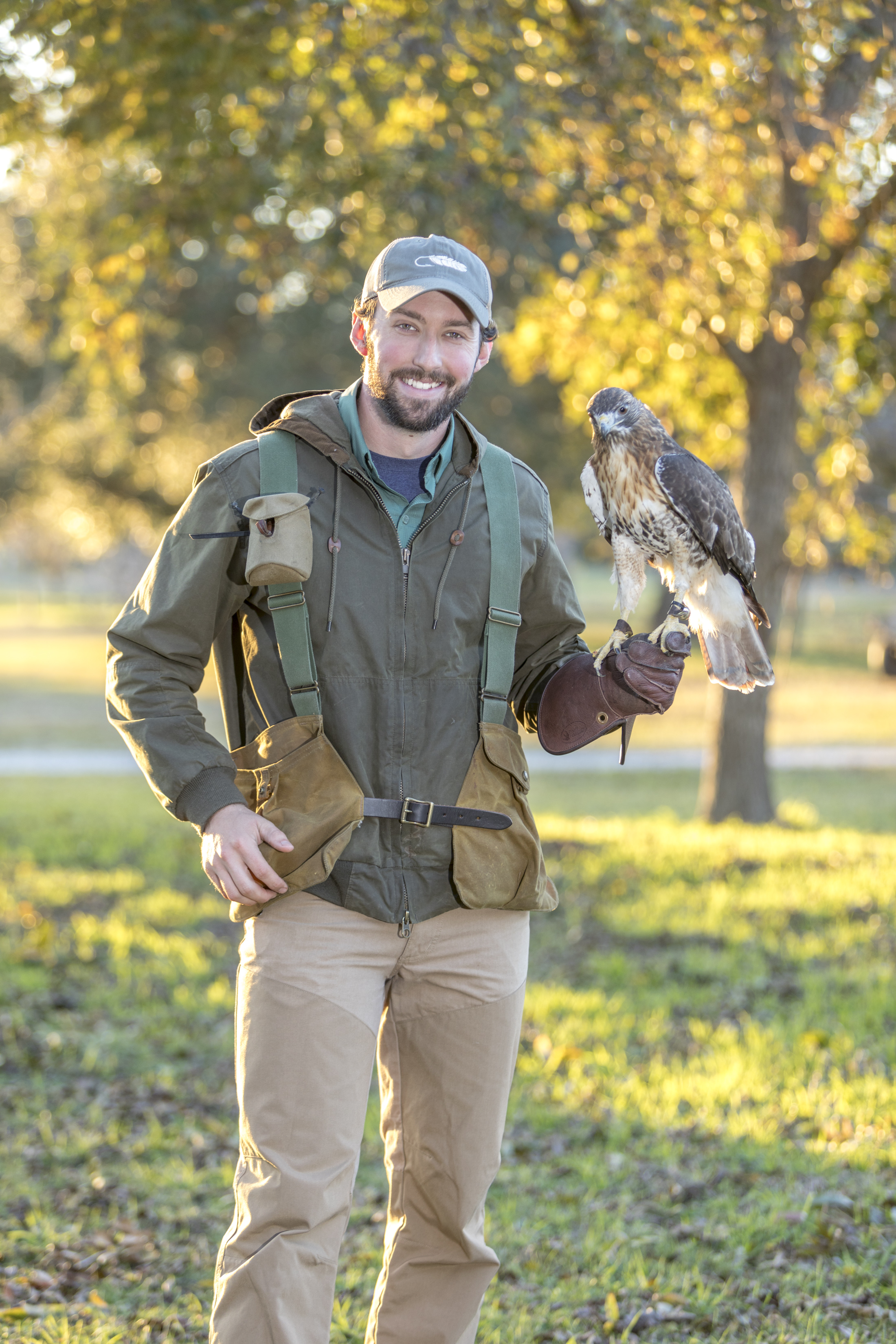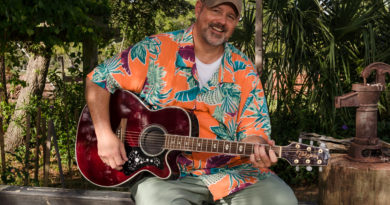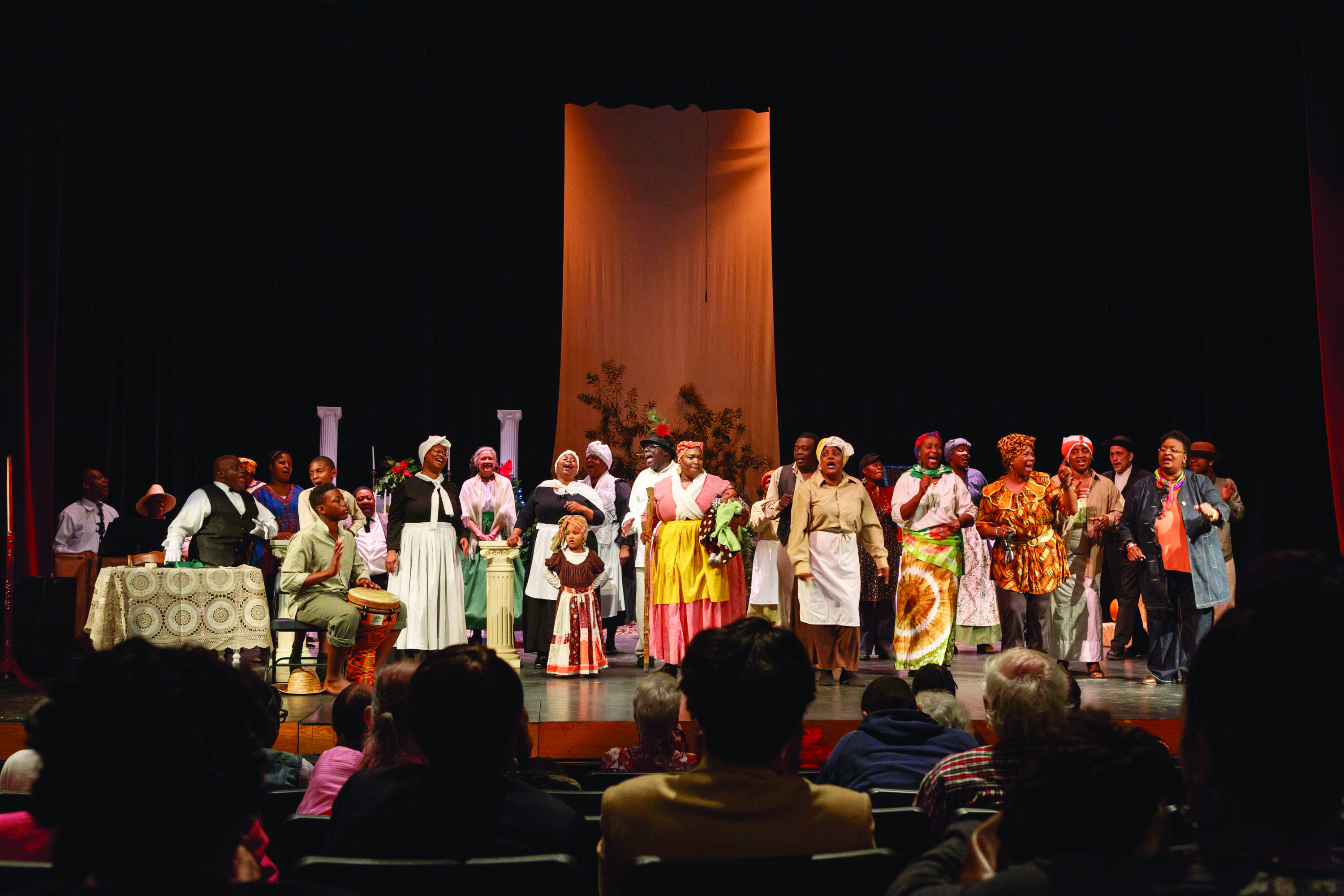Bruce Dunbar : Falconer of the Lowcountry
story by Cindy Reid photos by Paul Nurnberg
Falconry is the hunting of wild quarry in its natural state and habitat by means of a trained bird of prey. Falconry is an art. It requires long hours, constant devotion, finesse, subtlety and skill. The falconer must train a bird of prey to fly free, hunt for a human being and then accept a return to captivity.
In a sport that started thousands of years ago, one might be surprised to find a practioner here in our modern world. But really, nothing should be a surprise in the lowcountry, not even a current day falconer and his very well trained bird of prey.
Met Bruce Dunbar, General Falconer. He and his hawk, David, make an elegant and sure footed team as they tramp and fly, respectively, through the gorgeous live oaks of a local pecan farm on a hunt. David, a four and half year old Red-tail hawk, swoops and glides above our heads, never going far from Bruce, as they work in tandem in a present day illustration of this truly ancient art.
Being a falconer is something rare in our society. Bruce says, “There are only 2000 to 3000 practicing falconers in the country, out of 5000 licensed falconers. It is a very long process to become a falconer, it requires a substantial amount of time and resources upfront, and it’s not something to be taken lightly. It is not just a sport. Falconry is a lifestyle.”
Becoming a Falconer
Bruce, originally from Atlanta Georgia, attended Georgia Southern and graduated in 2013 with a degree in Biology. He says, “In college I wanted to do more with wildlife, but I didn’t know what I wanted to focus on so I started volunteering and then working at the Center for Wildlife Education and the Lamar Q. Ball, Jr. Raptor Center on campus. “ He worked at Georgia Southern’s Center for Wildlife Education for two years as a student volunteer and after graduation as Assistant Curator for two years.
Bruce says he became interested in becoming a falconer while working at the center. The center’s director and Master Falconer Steve Hein trained Bruce, guiding him through the laborious process and apprenticeship necessary to become a licensed falconer. Bruce is a currently a General Falconer and is now able to train others, although he stresses that becoming a falconer is a deep commitment.
David
An apprentice falconer must catch their bird in the wild and are required to have a license and a sponsor before doing so or they can be charged with a federal crime and go to jail. A young hawk is captured in the wild, after it has learned to hunt, but before it is an adult. After capture, the extensive training begins. This is not training a pet or exotic bird. This is training solely directed in the art of hunting live animals as a team of human and bird of prey. Of training, Bruce says,”A falconer’s main goal is to earn the birds trust.”
Bruce’s bird David, a male Red Tailed Hawk, was trapped by Bruce in Georgia in the winter of 2013. The training and expertise needed to train and care for a bird of prey is very extensive and requires much time, commitment and patience. Not only does the falconer need to train the bird, they must also learn everything about caring for a wild bird including learning to diagnose and treat raptor ailments, which can include fungal infections and West Nile disease. Their diet is specific; raptors are obligate carnivore and subsist on a diet of raw game meat such as mice and quail, which generally has to be mail ordered. David weighs 2.2 pounds, which is a good healthy weight for this bird.
They are not what we would term sociable animals. Bruce says, “Red-tails are solitary animals and, outside of mating season, see other raptors as threats and competition.” They are entirely self sufficient. “David would be fine if left in the wild, he would be able to feed himself and would survive just as well as if he never been in captivity,” says Bruce, “ His lifespan would most likely be shorter though, hawks in captivity live up to and around twenty years, but in the wild only around two and a half years. “
Bruce uses a travel box to transport David to hunts and demonstrations and says “Hawks get used to whatever you condition him to do. He does very well at demonstrations and will be perfectly content on his perch. As long as he is used to something he will do well. Stress for a hawk is whatever he is not used to.”
The Hunt
Falconry is a hunting sport. Some falconers work with a trained hunting dog, others work as a team of falconer and bird only. Bruce and David work together, and Bruce’s job is to flush game out for David to spot and kill. Squirrels, mice, rabbits and other small mammals are what they are hunting. Bruce says the Red-tailed hawk needs open spaces. “Red-tails thrive best in open forests and fields. This is a hunter,” he says, “and he is constantly looking for movement.” David’s visional range is two to three miles but he doesn’t wander far; in fact you can almost always see where he is during the hunt.
Bruce says, “Red tails sticks very close because they need to be in the action.” David follows Bruce, watching from trees, and he will swoop down in response to Bruce’s whistle commands. Small bits of food also bring the hawk down to Bruce’s gloved hand. Bruce says, “He sees me as a food source and responds accordingly.”
Seeing David in action is a thrill. All economy of motion, he flaps his wings in forward propulsion, then flies in a silent glide. It all happens very fast. He is in complete control of himself and the situation.
Like all birds of prey used by falconers, David has bells fastened on his legs. This is so the falconer can tell what the bird is doing and where he is based on the slightest bell sounds. Bruce says he is always listening to the bell and can differentiate between the slightest variations and so knows where David is at any time out in the field. They are a team, man and bird, working together.
Watching the two work together one can see the years of training and trust that has been established between them. There is deep respect and appreciation on Bruce’s part for what this magnificent bird is able to do, and for what they accomplish together.
Lowcountry Life
As regarding the past and future of the sport Bruce says, “Falconry has been documented as far back as 2000 BC, when raptors were being used by humans to hunt in ancient China. It is the predator most referenced in history.” And of today he says” Falconry is currently experiencing a renaissance in United States. It has only been in the US for roughly 100 years and the number of falconers has doubled in the past twenty years in the US. North America has brought new birds into the falconry world such as the harris hawk which is now one of the most used birds in the falconry world.”
Bruce lives on Fripp island with his girlfriend Jessica Miller, the Head Naturalist for Fripp Island. That works out well because as Bruce says, “When you live with a naturalist, it’s ‘oh we have a hawk living with us’, and takes it all in stride.” After three years of professional falconry in the Brunswick GA area, Bruce is currently employed at Fripp Island and available for falconry hunts and demonstrations through On The Fly Outfitters out of Brunswick, GA. (Contact info is through their face book page or call Adam Hein at 912-536-5808.)
“Falconry means something different to everyone. It is a connection to nature that you can’t get anywhere else. It is a primal event and you are in the front row to the action.” He pauses and says, “Personally, it speaks to me and keeps me going.” Watching Bruce and David working together is a rare treat and speaks to all of us who in thrall to our natural world.




